#reduced speed
Explore tagged Tumblr posts
Text
Viteza minimă pe drumurile din România: Ce spune legea și ce sancțiuni riscă șoferii care circulă prea încet?
Pe drumurile din România, reglementările rutiere stabilesc limite maxime de viteză pentru a preveni accidentele, însă există și situații în care legislația prevede sancțiuni pentru conducerea cu o viteză excesiv de redusă. Iată cum se aplică aceste reguli și ce trebuie să știe șoferii. Viteza minimă și accesul pe drumuri de mare viteză Conform Art. 74, alin. 1 din legislația rutieră: „Pe…
#amenzile șoferilor#Art. 74#Article 74#Autostrăzi#bam#diagnosis#diagnoza#driver fines#Drumuri expres#drumuri România#expressways#german#highways#legislație rutieră#minimum speed#neamt#penalties#reduced speed#Reguli de circulație#road safety#roman#Romanian roads#sancțiuni#siguranța rutieră#slow traffic#traffic legislation#traffic rules#trafic lent#viteză minimă#viteza redusă
0 notes
Text


#I got NTSC composite artifacts working with my CRT sim#gifs at 1/3 speed to reduce judder#I just learned that you can't make a 60 fps gif#gif#crt#simulation#retro#digital art#pixel art#artists on tumblr
2K notes
·
View notes
Text
Magneto had a really great character arc in the 80s which just got completely chucked in the bin because the new editor taking over the title thought that he should always be a one-note maniacal villain, and I'm disappointed to see X-Men '97 doing the same because the ex-showrunner wanted to recreate his favourite issue.
#x-men#x-men 97#x spoilers#never liked fatal attractions#it isn't a good story#and it terrible for magneto#reducing him to what he was back in the 60s#it is only really remembered for that one moment#which i never really cared for either#and i just feel like the character work has really suffered to cram this entire storyline in#it's like rather than take their time to develop these stories natural#or even try to improve on the flaws of the original work#they're just trying to cram in as many famous moments from the comics#just in case they don't get pick up for another season#there's a severe case of cancellation anxiety about the show#story arcs they could've at leave been two parters are being done in one (like inferno)#and now they'd trying to do three different big arcs all in one#which e is for extinction and ozt were fine together#but pushing in fatal attraction as well just feels like too much#and frankly it is putting me off the show#i'm not here to just see a speed run of x-men greatest hits#i want to see these stories adapted with care and consideration
32 notes
·
View notes
Text

Tip: fucking hate lining the outside of whatever you’re drawing for whatever reason that particular day? Lasso tool with border layer setting then brightness to opacity baby
#wips#For a brief period I did a lot of lineart this way after injuring my shoulder from drawing all day#which is also why I don't like to keep comms open all the time anymore lol#Definitely helped speed things up and reduce the strain though
35 notes
·
View notes
Text





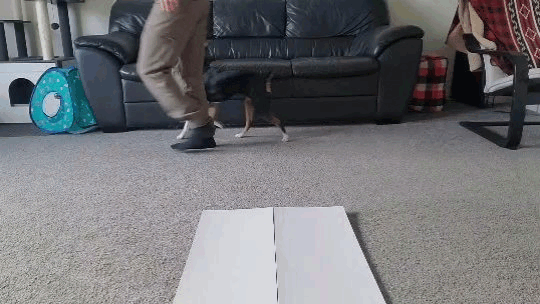

We...don't have a broad jump.
#crying at these jumps#we need a bigger space so I can keep moving and call her back into heel#I'm hoping if we cover a lot of low + long objects that we can maybe translate this to a broad jump?!#once there's more commitment to jumping the flatter obstacles I can reduce my speed#we somehow made it through advance without a broad jump but there's no way that's going to happen in excellent#only four more weeks 😬#I don't train this dog nearly enough for this and yet somehow she is the most perfect creature <3
27 notes
·
View notes
Text
Why are obstacles on the tracks a problem?
Previously, I mentioned that when a train encounters an obstacle on the line such as a tree branch, what happens is a complicated physics process that results in the train pushing the branch along the line. Here I will explain that process, but be aware that complicated physics things are about to happen. There are some pretty diagrams to look at though, so if you want you can look at those and then skip to the end for a summary. They're even in color!!
First of all, some basic setup (before putting some numbers in):
We have a train travelling at an initial velocity u, with mass M, and an engine capable of producing a constant power P (we will use this to restore the train's velocity to u if it decreases for some reason).
The train encounters an obstacle on the line, such as a tree branch of mass m. We will assume (for now) that the collision is elastic - that is, no energy was lost (for instance, as sound).
We are also assuming a frictionless vacuum, cylindrical tree branch, and rectangular train.
To start with, we look at conservation of momentum (figure 1):

Since the train has elastically collided with a branch, its speed is reduced, given as Vtrain . As trains are typically much heavier than a single tree branch, we take M >> m, and so Vtrain ≈ u.
However, this is somewhat unrealistic, as when a train hits an obstacle, energy is lost –as a crunch sound, for instance– so it may be more appropriate to assume an inelastic collision. Since I said that the branch sticks to the train (and I am right), we should assume a completely inelastic collision, where as much kinetic energy as possible is lost.
Again, we look at conservation of momentum (figure 2):
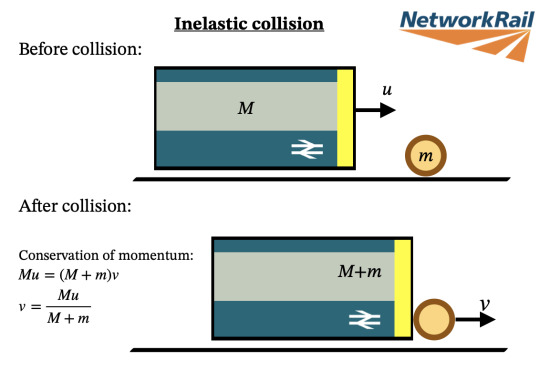
In this case, if we again assume M>>m, we still get v ≈ u.
Since we know from reality that problems will happen if the train collides with the branch, this tells us that we have made an unrealistic assumption somewhere. In this case, it must be the assumption that the train's mass, M, is large enough that the branch's mass m can be ignored. So, without this assumption, we look at how long it takes the train to get back to its initial speed, using the equations for motion under constant power (equations derived from Taylor, 1930 and shown in figure 3):
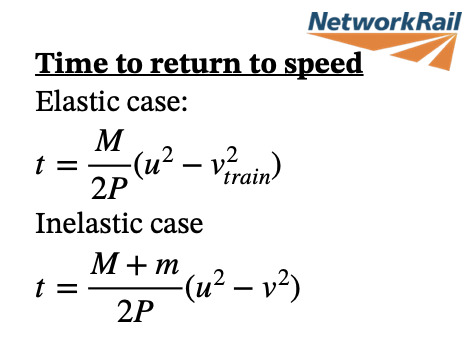
To find how much energy is used in each case, simply multiply the time by the power.
By now, you may be wondering what the point of all this is – after all, I haven't actually shown you if this is meaningful. So let's add some numbers to this and see how reasonable all of our assumptions were!
If we take the train's mass to be M=30 tonnes (30,000kg), its power P=1500kW, and its initial speed u=40 m/s (144 km/hr) respectively; and assume the branch has a mass m=5kg (that seems reasonable, right? Trees are mostly water, which is 1kg per cubic meter, and if it has a radius of 0.5m and a length of 1.435m, it should be about that much), we can calculate all the various things we need:
First, the final velocity of the train and branch in the inelastic case (see figure 2 for the equation):
v≈39.99m/s which is pretty close to the initial velocity.
The time taken to return to speed (fig. 3) for the train/branch system is:
t≈0.0053s
This is quite fast, but hold on: the energy used to do this is about 8000 joules, which is probably quite expensive at current electricity prices, but those are given in kWh and I really don't feel like converting between them. (8000 is a big number, right?)
For the elastic case, things are a little bit more complicated, as we have two different velocities to calculate (figure 4):

If you were just looking at the pictures and are upset that the last two have been equations, don't worry, the next one isn't.
Vbranch ≈ 79.99 m/s
Vtrain ≈ 39.98 m/s
The time taken to return to speed:
t≈0.0094s
This is almost double that of the inelastic case, resulting in the energy used increasing to the enormous –and probably expensive– value of 14 kJ. (I even needed to use an SI prefix this time! And one of the ones that makes things bigger!)
However, both of these cases also reveal some interesting things about the situation: the elastic case has the tree branch launched away from the train at 80m/s, which is about 288 km/hr. Since the train and branch are likely irregularly shaped, the branch probably won't be pushed along the tracks at 290km/hr, and could instead be launched into the air space towards you. Nobody wants to be in the situation where a tree branch is flying towards you at almost 300 km/hr. I could do some math to see how much it would hurt, or if you could reasonably expect to dodge it, but I think we can just assume it will be quite painful.
Historically, trains avoided flinging branches at nearby passengers at almost 500km/hr (that's half the speed of sound) by employing a triangular device on the front of the train to deflect objects such as cows off the tracks. These were particularly common in North America, where lineside fences have yet to be discovered outside of the Northeast Corridor and it is easy for things to wander onto the tracks. However, thanks to innovations by the Budd company and others, more recent american trains are basically indestructible, rendering obstacle deflectors unnecessary. The effects of the obstacle deflector are shown below (figure 5):
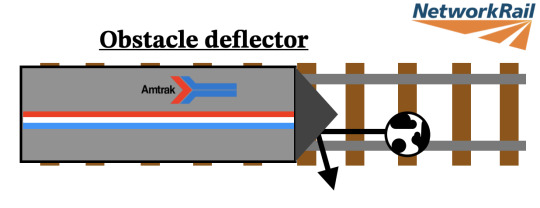
This device is known in America as a burgerizer, since it can provide an easy meal for the train crew –two of the five ingredients for a cheeseburger right on the front of the train, more if you're lucky– although since usually the obstacle is shoved off the track, the British name of "cowcatcher" is misleading, especially if you hit a truck instead. The burgerizer's physics can easily be calculated using conservation of momentum, but this involves vectors, and I don't want to deal with vectors right now is left as an excercise for the reader.
In the inelastic case, we note that the branch sticks to the front of the train. Since the inelastic case is more realistic (I will not justify this statement), this means that other things will also stick to the train. By the time the train reaches the end of the line, the mass of the things stuck to it may end up not being negligible (figure 6):
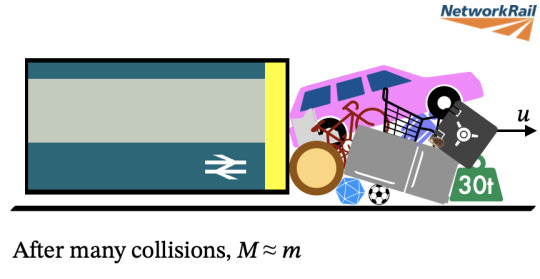
If the train is electric, this will strain the power grid and could lead to power cuts elsewhere as more energy is given to keep the train running at speed. If the train is diesel, it will be unable to provide constant power and could slow down (an electric train has access to every power station in the country if the need arises, a diesel train just has its onboard generator or motor AND a limited amount of fuel).
This mess is also difficult to clean up, and could damage the track as it is pushed along. Also, although we have been ignoring friction (since trains have very little rolling resistance) this pile of stuff will cause friction to be very noticeable, and could even obstruct the driver's visibility – potentially leading to more collisions.
–//–
Now that you have read through all of the calculations (or looked at the pictures and skipped the rest), you should have a thorough understanding of why we have to stop trains to clear things off the line, and can't just plow through them like in the movies. (I assume this happens in movies, I have not checked)
TL;DR: When the train hits a branch, either the branch goes flying towards you really quickly, at basically 1000km/hr, which is approximately the speed of sound; or it sticks to the front of the train and becomes part of a massive pile of things that gets in the way and slows down the train.
Finally:
I put the images together using the shapes in my computer's word processor (except the various rail logos); while the equations of motion under constant power are from this paper by Lloyd W. Taylor (published in 1930, I believe). Also thanks to @cosmos-dot-semicolon for peer reviewing this, any errors are not my fault.
#network rail#physics#trains#network rail essays#I spent way too much time on this you better appreciate it or else#I would not want to get hit by a tree branch moving at roughly mach 2#yes that is a spherical cow in figure 5#please do not leave refrigerators on the railway it is not good for them or the trains#and yes I did get the density of water wrong by a factor of 1000#I want to change it but I think it's funnier if I leave it as it is#a small branch probably is about 5kg though#but if I did use the correct density then the mass of the branch would be 5 tonnes and that very much isn't negligible#in the inelastic case the train's speed is actually reduced to 34m/s and in the elastic case it's reduced to 29m/s which is quite a lot#this also means that the speed of the branch in the elastic case is a thousand times higher at nearly 1.000.000km/hr#which is about 0.09266c so that is quite fast and it's a good thing the collision is inelastic since otherwise it could destroy a city#also I have decided that the train used in these calculations is the BR Class 000
6 notes
·
View notes
Text
rivals update nerfing every single healer. ough the misery
#its fine i love having dps who are pissed abt 'no heals' it rlly puts some zest into my gameplay#reducing mantis health like u took away her speed.#TURNING ROCKETS ULT INTO A DEFENSIVE ULT im seething#and removing his healing over time why change his gameplay so much ;-;#happy abt emma tho. ig.
2 notes
·
View notes
Text
walked outside of my dorm and a blast of snow and wind hit me in the face. #this is just like the white vault
#does anyone want to go to an arctic research station and slowly loose the rest of our fellow research team with me#this also happens in the thing but white vault is My Arctic Horror#In the winter months gale storms in Svalbard can reach wind speeds of 130 km/h. Accompanied by or following snowfall such storms can reduce#visibility dramatically more so in the frigid months of the polar night. During these storms Travel Is Not Advised
4 notes
·
View notes
Text
Me, driving on a small two-lane road with some foot traffic: Damn it's crazy how going the speed limit will piss so many people off like
The carbrains on Tumblr: Um I GUESS if you want to go the "speed limit", you fucking cop, or whatever that's on you but stay out of the left lane (there is no left lane) or the person behind you will be morally correct in committing vehicular homicide!!!!!!
#imagine if they knew about all the studies that prove that if everyone drove the speed limit it would actually reduce travel time#littlemermaidcreepyoldmanwithpipe.jpg#anticar#anticager#kill cars
36 notes
·
View notes
Text
THIS COLLEGE SHIT IS EASY
#i jus got my final grades back for the semester FINALLY an i have all A's....#paying for it however... not so easy#im taking an extra class next semester an might take summer school so i can speed up my time here an reduce the amnt of rent im paying#also cuz i am tired of being here the other kids dont like me so id like to reduce the amnt of time im here#im extremely close to dropping out at all times the only thing stopping me is that the classes themselves are like#the easiest ive ever had in my life. literally have like 4 assignments per class for the entire semester....#i got nervous abt my final but im like 90 percent sure they didnt even read that shit tbh#being in college is like humanities majors r going la la laaa and stem majors are getting brain damage from lack of sleep
6 notes
·
View notes
Text
Today was the last DND session for a three-year campaign and I am big sad :(
One of the players brought whiskey for a last toast, which was very kind of them. I had never had whiskey before. Turns out I do not like whiskey. Unsurprising.
It tastes like slightly nicer hand sanitizer.
#blue chatter#it was a flavored whiskey as well#everyone else who had it said it was rly smooth and sweet#so I don’t think I super wanna know what regular whiskey tastes like#it was supposed to be like vanilla caramel flavored or smth#I was told it was like cream soda and that was a LIE it was like disinfectant#with a vanilla aftertaste#the campaign went rly rly well though#I’m seriously going to miss it#the final boss battle was just pure catharsis we absolutely whaled on that dark abberant goddess#she got Destroyed#an entire section of the continent restructured bc of the removal of her corruption#I rly like that my character got to be disabled at the tail end of this campaign#they wielded experimental magic that wasn’t supposed to work and resurrected someone who the Keeper very intentionally kept dead#it worked because they partially fused with Arawai the goddess of life and became her aspect on earth#but becoming partially divine in a mortal body takes a toll#they had more and more limited mobility and the more they cast magic to compensate the more of a toll it takes#functionally that meant my movement speed was reduced#and I lost more abilities after each combat as the consequences of overextending myself caught up to me#I wish I’d gotten to play this longer to see how this ended mechanically but it was a lot of fun to get a character who is both#very magically competent and still disabled and that still affects their ability and they still get the dignity of risk#to choose whether to continue casting or not knowing the consequences of doing so#it is very much a fantastical disability which I flavored heavily off of chronic fatigue and a mobility disorder#in-game their skin became hard and brassy around their joints which make them difficult and painful to bend#they lose a lot of sensation and fine motor control#thankfully they have a lot of money from their adventuring so they can commission an accessible house and mobility aids#and their friends help take care of them
10 notes
·
View notes
Text

#so anyways I got an ear filter for my recent capd diagnosis and then the first day I was in the zone for 5 hours straight.#still to early to tell if it was really the filter but I mean. I mean. I thought I was gonna crap out 4 hours ago.#actuallyautistic#actually autistic#actually adhd#actually capd#(central) auditory processing disorder#fun fact it’s an academic argument about whether it should be called capd or apd but it’s all the same thing#your neurons transfer the signals from your ears up to your brain at slightly different speeds#and so the audio signals you get are slightly desynced#what the filter does is physically slow down the sound as it travels thru one ear#thus resyncing the audio and reducing your subconscious load#fascinating stuff.
8 notes
·
View notes
Text
oh I didn't notice the siphoning strikes change either dbjhjbngdf
#saint plays eso#maybe I should read my tooltips lmao#everything for the most part still feels the same which I like. not unexpected bc eso works a lot like g.w.2 in that sense#the bow/siphoning strikes changes reduce some of NB's timer insanity which is nice#the insane button mash speed is still there bc you're still flipping bars every 10s to refresh wall of elements#I ofc miss the insanity that was watching mag!NB's three million timers but I think making them on-bar passives is a good change#I like that SS is passive and you only activate it for emergency mana while sapping your hp that's really fun
2 notes
·
View notes
Text
I went for a run this morning and now there is nothing else that requires my attention for the rest of the day. how wonderful
#random text post silliness#still on a very reduced mileage but i'm getting some good speed work in#lynne vs running injuries
7 notes
·
View notes
Text
before televisions and computers, we had books. before books we had paintings and drawings. before paintings and drawings, we had verbal storytelling. now we have all of these things at once
aren't we so very fucking lucky!
#humans will invent amazing things and then a section of humans will dunk on other humans for using said amazing things#also stories are millions of ways to express the sheer beauty and rawness of our very souls#in ways that involving the act of creation. the ache of creativity#we yearn to create with such a need that we clearly inherited from god himself! made in his image indeed#the human capacity for story telling is a gift#i have no doubts there are other sapient beings in the universe who do it too#but right now. on this planet. creativity is so our hat#i can't reduce humanity to one word but i can do a few and ''creative'' and ''imaginative'' is two of 'em#the others would be ''determined'' ''stubborn'' ''reckless'' ''loyal'' and ''insane''. oh and ''inventive'' duh#inventive is much like creative but i gotta shout out to how inventive humans are because thats Our Thing#other animals have like strength and speed and we have our juicy powerful brains#thinking up very specific machines and chemical combinations#guys we're so fucking cool. you ever notice that
7 notes
·
View notes
Text
got pulled over by a cop last night and got a $50 speeding ticket, however, he called me sir when he first got to the window, so. epic highs and lows, every cloud has a silver lining, etc.
#i of course immediately had to hand over my drivers license w the F gender marker on it but still#nice and validating for me personally#the speeding ticket was less validating but i think him realizing that i am NOT a 25 y/o cis guy helped bc he reduced the ticket for me lol#someone come back in 14 days and ask me if i remembered to pay the fine bc otherwise my license will be suspended#q talks
5 notes
·
View notes